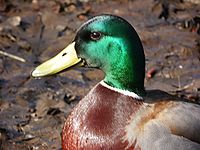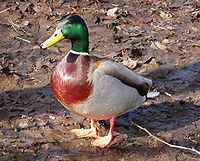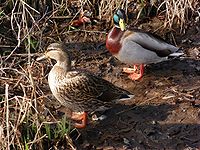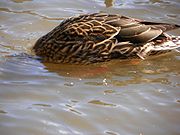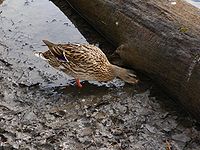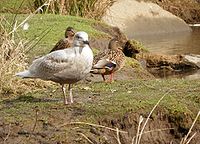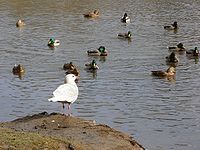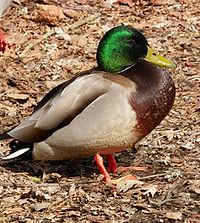Anas platyrhynchos
From marinelife1011
| Anas platyrhynchos | |
|---|---|
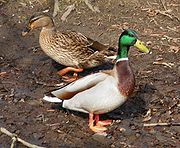 |
|
| Mallards wintering in a South Puget Sound Estuary | |
| Scientific classification | |
| Kingdom: | Animalia |
| Phylum: | Chordata |
| Class: | Avesia |
| Order: | Anseriformes |
| Family: | Anetidae |
| Genus: | Anas |
| Species: | A. platyrhynchos |
| Binomial name | |
| Anas platyrhynchos Linnaeus, 1758 |
|
| Synonyms | |
|
Mallard or wild duck Category: Articles with 'species' microformats |
|
Anas platyrhynchos is commonly known as the mallard or wild duck. Mallards are migratory dabbling ducks, common throughout Europe, Asia, North and South America, North Africa, New Zealand and Australia. Mallards are often found in farms and urban parks, they inhabit Estuaries, swamps, marshes, ponds, rivers, and inter tidal regions. 93% of Puget Sound mallards are found in intertidal habitats with adjacent farmland. They are the ancestor to most domestic ducks and can produce successful hybrids with other anas species. Often hunted these ducks are curious and easily tamed, making them a popular pet in rural settings. Dabbling ducks are opportunistic feeders, eating almost anything that will fit in their bill and are often employed in pest management for small farms and gardens. Year round residences of the Pacific Northwest, mallards are our most widespread inland duck.
Contents |
Physiology
Mallard ducklings are yellow with black streaks near the eyes and down the back, with black feet and bills.
As the ducklings mature the plumage changes to a drab mottled brown, male’s bills become yellow, female's will stay black or change to orange. Females retain the drab mottled brown plumage (shown on the right) throughout their lives, but a skewed sex ratio has lead to sexual dimorphism; male ducklings slowly develop brighter plumage, in the characteristic mallard pattern. A mature male in breeding plumage (shown on the far left) has grey wings and body, an iridescent green neck and head, separated from a purplish chest with a white ring, a yellow to reddish black tipped bill and a curly black tail. Domestic Mallards are available in a variety of colors. Average adult Mallards weigh 32-42 0z, are 56-65 cm (22-26 in) in length, with a wingspan of 81-98 cm (32-39 in), but size varies with region; those that live in colder environments tend to be larger than their temperate residing conspecifics (Mack, Clark, 2006).
Population Genetics
DNA analysis has found genetically distinct mallard populations in the Old World, the New World, the Aleutian Island, mainland Alaska/Eastern Asia, and the Russian Far East. Mallards can migrate several thousands of miles from summer nesting grounds to winter mating grounds or may reside year round in temperate regions, if water is available. Mates are chosen in late fall and early winter when populations are condensed in temperate regions. In the spring drakes follow their mates to nesting sites near her hatching ground. Males end up nesting far away from their hatching grounds, as a result genetic drift in mallards tends to be paternal, rather than maternal (Kulikova et. al., 2005).
Diet
Mallards are omnivorous, dabbling, filter feeders and grazers. Their natural diet is diverse consisting of crustaceans, gastropods, invertebrates, and plant matter. Duckling growth and survival rates have a strong correlation with aquatic invertebrate availability (Johnson, Butler, 1998).
Domestic Mallards are typically fed dry commercial, grain or soy based diets. Commercial foods are typically 1cm in length much larger than the 3mm wild prey; the larger food can clog the lamellae used for filter feeding. Commercial diets are largely undigested, and contain 6-9 times less fiber than natural diets. Birds fed commercial diets have shown signs of vitamin, mineral and amino acid depletion, as well as lipid and protein catabolism (Dabbert et. al. 1996).
Courting
Courting begins in late fall, drakes sport their bright breeding plumage from September to June. Males gather and form display groups. Females join the party and begin Nod-Swimming to cue the males wooing. Drakes whistle, grunt, preen and bob their heads. Besides dancing skills, females look for bright bills and plumage (Omland, 1996).
Early imprinting seems to be associated with male mate choice, resulting in a mallard Oedipus complex of sorts. Mallard drakes raised by intrespecific foster mothers, tend to choose mates that resemble their foster mothers, parental imprinting does not seem to effect female mate choice (Bossema, 2011).
Females will signify interest in choice males by inciting him, if accepted the male will persistently follow the female, creating a pair bond that may last through the breeding season, often pair bonds made in early fall are reconsidered later in the season. Once a pair bond is formed, drakes guard their mates from other paired-males who attempt to increase reproductive success through forced extra-pair copulations. Paired males experience a spike in testosterone and may become very aggressive as breeding season nears (Davis, 2002). Females actively resist extra-pair mating and are often injured or even killed while attempting to escape. Unpaired males have lower testosterone levels and are less aggressive in this regard, tending to focus on forming a pair-bond rather than spending energy on forced copulations. Unpaired males will sometimes form bonds with couples, where a subordinate male will closely follow a male/female pair. In 70% of these trios both males actively defend the female. But dominant males prevent subordinate males from approaching the female during mating periods (Goodburn, 1984).
Nesting
Nesting sites are chosen in early spring by the females, who often choose their home nesting sites. Successful females choose small home ranges in wood shrub habitat, seasonal and semi-permanent wetlands are popular nesting sites (Mack, 2006). Mallards are Gregarious animals and tend to choose nesting sites with neighboring Mallards.Conspecific settling may indicate habitat quality and has been linked to nesting site selection, but the choice is ultimately based on habitat suitability not the presence of conspecifics (Poysa, 1999). Nests are built on the ground, in tall shrubs or grasses, with soft grasses and reeds.
Brooding
In Early spring the female lays a clutch of 8-13 eggs each weighing 1.75oz, an average clutch weighs 15.83 oz about half the mothers body weight (Ackerman,2006). Drakes are most protective of their hens during periods of high fertility, they leave after seeing her eggs laid, successful guards can be confident the eggs in question are indeed his (Goodburn 1984). Drakes gather, begin to moult their bright breeding plumage, and are unable to fly.
Eggs are laid one per day and covered with down from the mothers belly, incubation doesn't begin until the last egg is laid. Eggs are incubated for 27-28 days, during which time nests are targeted by brood parasites as well as predators. Mallard mothers accept "parasitic eggs" as long as they resemble their own.
Ducklings can feed and swim upon hatching, but imprinting keeps them close to their mother for the first 50-60 days for protection and waterproofing. Ducklings don't produce the waterproofing oils needed for swimming, they rely on oils produced by their mothers and applied while grooming. Duckling mortality is highest during the first two weeks where predation is high and ducklings are vulnerable to weather related mortality. The ducklings diet during this period consist almost entirely of aquatic invertebrates, growth rates strongly correlate with prey density (Johnson, 1998).
Mallards as an invasive species
A. platyrhynchos has been introduced into Australia and New Zealand where it successfully hybridized with the native Grey Duck, and the island of Oahu where it hybridized with the Hawaiian Duck. The Mallard’s abilities to adapt to varying conditions and successfully hybridize with other dabbling duck species, gives it a competitive advantage over many endemic species, threatening the genetic diversity and adaptive fitness of these populations. North American Mallards are expanding eastward, hybridizing with the American Black Duck. Black Duck populations in these areas are sharply declining. Mallards have been documented hybridizing with the Eastern Spot Billed Duck and the Mottled Duck (Kulikova, et al., 2005).
Human affects on Natural Mallard Populations
Natural populations of mallards are often supplemented with hand reared ducklings of unknown genetic origins, leading to shifting geographical ranges, and genetic pollution. Increasing natural and artificial hybridization may lead to a decrease in overall fitness and places the mallard’s genetic identity at risk (Barratti et. al., 2008).
Changes in bill morphology have been detected after only thirty years of supplemental stocking. Farm raised ducks have adapted a decreased lamellar density in response to the dry feeding on a grain based diet. Commercial feed particles can be 1cm in length while the natural prey of this filter feeder is usually less than 3mm; this has lead to a 10% decrease in lamellar density in wild stocks. Captive bred ducks have been shown to have reduced brain volume when compared to wild conspecifics(Champagnon et. al., 2010).
Winter temperatures are a limiting factor in dabbling ducks who rely on liquid water for feeding; an increase in global temperatures may be leading to improved wintering conditions. Improved body condition and an 11.7% body mass increase have been observed in Mallards and sympatric Teals since the 1950s (Guillemain et. al., 2008).
Sources
All photos by Dezi Rose, rosdez31@evergreen.edu
Ackerman, Joshua T., John M. Edie, Thomas G. Moore, Does Life History Predict Risk Taking Behavior of Wintering Dabbling Ducks?,The Condor Vol.108 No.3 (2006), pp.530-546
Champagnon, Jocelyn, Matthieu Guillemain, Johan Elmberg, Karin Folkesson, Michel Gauthier-Clerc, Changes in Mallard Anas platyrhnchos bill morphology after 30 years of supplemental stocking., Bird Study Vol.57 (2010), 334-351
C. Brad Dabbert, Kenneth C. Powell, Thomas E. Martin, Effects of Monotypic Diets of Soybean, Rice and Corn on Mallard (Anas platyrhynchos) Physiological Status, Journal of Zoo and Wildlife Medecine, Vol.27, No.2 (1996), pp.248-254, Dispersal, and Lineage Sorting Contribute to Complex Geographic Structure. The Auk, Vol.122, No.3 (2005), pp.949-965
Kulikova, Irina V., Sergei V. Drovetski, Daniel D. Gibson, Ryan J. Harrigan, Sievert Rohwer, Micheal D. Sorensen, Kevin Winker, Yuri N. Zhuravlev, Kevin G. McCracken, Phylogeography of thE Mallard (Anas platyrhychos): Hybridazation
Glenn G. Mack and Robert G. Clark, Home-Range Characteristics, Age, Body Size and Breeding Performance of Female Mallards (Anas platyrhnchos., The Auk Vol.123, No.2 (2006), pp.467-474
Lovvorn, James R. and John R. Baldwin, Intertidal and Farmland Habitats of Ducks In The Puget Sound Region: A Landscape Perspective, Biological Conservation Vol.77 (1996), pp.97-114
Guillemain, Matthieu, Johan Elmberg, Michel Guathier-Clerc, Gregoire Massez, Richard Hearn, Jocelyn Champagnon, Geraldine Simon, Wintering French Mallard and Teal are Heavier and in Better Body Condition Than 30 Years Ago: Effects of a Changing Environment?, AMBIO Vol.39 (2010), 170-180
Weidmann, Uli, Plumage Quality and Mate Choice in Mallards (Anas platyrhynchos). Behavior,' Vol.115, No.1/2 (1990), pp.127-141
Bossema, I. and J.P. Kruijt, Male Activity and Female Mate Acceptance in the Mallard (Anas Platyrhnchos). Behavior Vol.79, No.2/4 (1982), pp. 313-324
Poysa, Hannu, Johan Elmberg, Kjell Sjoberg, Petri Nummi, Nesting Mallards (Anas platyrhnchos) Forecast Brood-Stage Food Limitation When Selecting Habitat: Experimental Evidence. Oecologia Vol.122, No.4 (2000), pp.582-586
Poysa, Hannu, Johan Elmberg, Kjell Sjoberg, Petri Nummi, Habitat Selection Rules in Breeding Mallards (Anas Platyrhynchos): A Test of Two Competing Hypothesis. Oecologia Vol.114, No.2 (1998), pp.283-287
Goodburn, S.F., Mate guarding in the Mallard Anas platyrhynchos. Ornis Scandanavica Vol.15, No.4 (1984), pp.261-265
Davis, Ellen, Male Reproductive Tactics in the Mallard, Anas platyrhynchos: Social and Hormonal Mechanisms. Behavioral Ecology and sociobiology Vol.52, No.3 (2002), pp.224-231
Omland, Kevin E., Female Mating Preferences for Multiple Male Ornaments: Natural Variation.Behavioral Ecology and sociobiology Vol.39, No.6 (1996), pp.353-360
Johnson, Douglas H. and Malcolm G. Butler, Mallard Growth and Survival in Relation to Aquatic Invertabrates. The Journal of Wildlife Management Vol.62, No.1 (1998), pp.124-133
